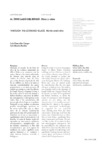Mostrar el registro sencillo del ítem
Al otro lado del espejo. Obra y ruina
| dc.contributor.author | Pancorbo Crespo, Luis | |
| dc.contributor.author | Martín Robles, Inés | |
| dc.date.accessioned | 2018-04-16T12:44:50Z | |
| dc.date.available | 2018-04-16T12:44:50Z | |
| dc.date.issued | 2017 | |
| dc.identifier.citation | Boletín Académico, 2017, 7: 29-44. ISSN 2173-6723 | |
| dc.identifier.issn | 2173-6723 | |
| dc.identifier.uri | http://hdl.handle.net/2183/20498 | |
| dc.description.abstract | [Resumen] Mediante el estudio de las fotos de obra de los edificios industriales de Albert Kahn y su semejanza con las ruinas clásicas y las ruinas industriales de Detroit, este artículo trata de analizar la relación entre dos fases que se dan durante el periodo de vida de un edificio. La obra y la ruina se estudian considerándolas dos partes pertenecientes a un único proceso. El análisis usa ejemplos como los dibujos de Joseph Gandy y Auguste Choisy, o las teorías sobre la ruina de Simmel o Robert Smithson para tratar de definir las convergencias y divergencias entre ambas fases y las características del proceso global en el que se encuadran. Partiendo de este análisis, se plantean posibles metodologías operativas en las ruinas industriales que se alejen tanto de la estricta conservación patrimonial como del actual estado de abandono en el que se encuentran, y equidistantes entre el monumento y el desecho. Se trata de buscar modos de operación en estos nuevos ambientes antropocénicos, ejemplarizados por las ciudades industriales de Rust Belt norteamericano, que sean capaces de establecer un nuevo equilibrio entre agentes humanos y no humanos y entre sistemas técnicos, culturales y biológicos.[Abstract] Using the study of the work in progress photos of Albert Kahn’s industrial buildings and their likeness to classical ruins and the industrial ruins of Detroit, this article attempts to analyze the relationship between two phases which occur during the lifetime of a building. Works and ruins are studied under the consideration that the two parts belong to a single process. The analysis uses examples such as the drawings of Joseph Gandy and Auguste Choisy and the theories on ruins of Georg Simmel and Robert Smithson, to define the points of convergence and divergence between the two phases and the characteristics of the overall process into which they fit. Based on this analysis, possible operational methodologies are suggested for the industrial ruins, steering away from the strict conservation of heritage and from the current state of abandonment in which they are now found, equidistant from being a monument and waste. The aim is to find modes of operation in these new anthropogenic atmospheres that are exemplified by the industrial cities of the North American Rust Belt; modes which are capable of establishing a new equilibrium between human and nonhuman agents and between technical, cultural and biological systems. | |
| dc.language.iso | spa | |
| dc.publisher | Universidade da Coruña | |
| dc.relation.uri | https://doi.org/10.17979/bac.2017.7.0.1851 | |
| dc.rights | Atribución 3.0 España | |
| dc.rights.uri | http://creativecommons.org/licenses/by/3.0/es/ | |
| dc.subject | Albert Kahn | |
| dc.subject | Rust Belt | |
| dc.subject | Arquitectura industrial | |
| dc.subject | Obsolescencia | |
| dc.subject | Reutilización | |
| dc.subject | Albert Kahn | |
| dc.subject | Rust Belt | |
| dc.subject | Industrial architecture | |
| dc.subject | Obsolescence | |
| dc.subject | Reutilization | |
| dc.title | Al otro lado del espejo. Obra y ruina | |
| dc.title.alternative | Through the looking-glass. Works and ruins | |
| dc.type | info:eu-repo/semantics/article | |
| dc.rights.access | info:eu-repo/semantics/openAccess | |
| UDC.journalTitle | Bac Boletín Académico. Revista de investigación y arquitectura contemporánea | |
| UDC.volume | 7 | |
| UDC.issue | 1 | |
| UDC.startPage | 29 | |
| UDC.endPage | 44 |






